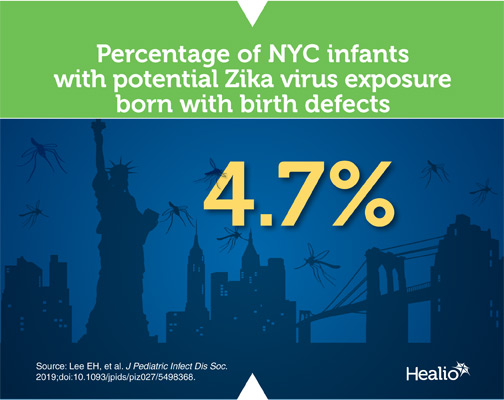Few infants in NYC with possible ZIKV exposure have associated birth defects
Click Here to Manage Email Alerts

Approximately 5% of infants with possible congenital Zika virus exposure had defects at birth potentially associated with the infection, according to results from a New York City cohort published in the Journal of the Pediatric Infectious Diseases Society.
Previous studies found that during the 2015 to 2017 Zika virus (ZIKV) outbreaks, approximately 20% of all pregnant women in the continental United States with ZIKV infection gave birth in New York City.
“Through collaboration with New York City providers, the health department was able to identify and evaluate a cohort of over 400 infants with possible congenital exposure to ZIKV,” Ellen H. Lee, MD, from the New York Department of Health and Mental Hygiene, told Infectious Diseases in Children.
Lee and colleagues followed the infants between 2016 and 2017 through their first year of life. They conducted interviews with providers and patients, as well as reviewed medical records to collect information about the women during pregnancy and the clinical and neurodevelopmental status of the infants at 2, 6 and 12 months of age, according to the study.

Most of the infants (n = 385; 95.3%) appeared well, whereas 19 (4.7%) had a possible birth defect associated with ZIKV, Lee and colleagues wrote. Seven (1.7%) had findings consistent with congenital Zika syndrome.
“This latter group had defects identified at birth that persisted through the 12 months of follow-up,” Lee said.
Twelve infants with isolated microcephaly were normocephalic by 2 months of age, according to the study. Laboratory evidence of ZIKV infection was found in 22 of the infants, of whom seven had a birth defect. Four infants without a birth defect who tested negative for ZIKV infection presented with a developmental delay at 1 year, the researchers wrote.
They noted that identifying and monitoring infants with ZIKV exposure remains difficult, requiring extensive efforts by providers and public health departments, which include surveillance, diagnostic testing, case investigation, provider education and community outreach.
“Continued collaboration between health care providers and health departments is key to identifying and monitoring infants with possible ZIKV exposure,” Lee said. “Providers should continue to consider congenital ZIKV infection for infants with consistent clinical and neuroimaging findings. To understand the impact of congenital ZIKV exposure beyond infancy, we need longitudinal studies using standardized clinical and neurodevelopmental assessments.” – by Joe Gramigna
Disclosures: The authors report no relevant financial disclosures.

